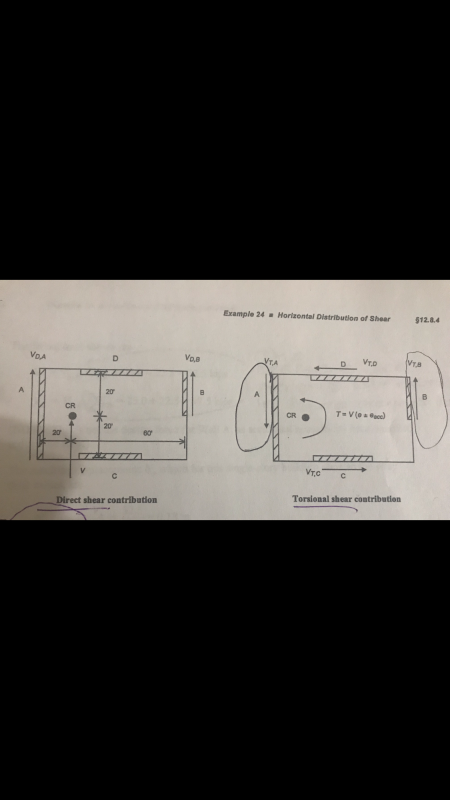Hi everyone. I was working on a problem from the IBC Structural /Seismic Design Manual and I have two questions I am wondering if anyone know, your answer would be appreciated. here goes:
1) when considering torsional and direct shear , is the torsional moment always assumed counter clockwise? The code and this example do not say anything on this. The example in this book uses counter clockwise and the only explanation it offers is that "the seismic force V applied at the center of mass CM is equivalent to having a V applied at the CR center of rigidity together with a counter clockwise torsion T." I don't know if its always counter clockwise though? it matters to because it affects the signs of a lot of the calculations I have to do after, like when calculating the amplification factor.
2) when calculating the torsional shears (the ones for the amplification factor. because there seems to be 2 sets of torsional shear equations, one for when calculating amplification factor and one for when calculating the actual torsional shears), it says we use the e+ e accidental only for both walls in question. NOT the e-e accidental. they use the e- e accidental when calculating the actual torsional shears. but my question is, do we always use the e+ e accidental only when calculating amplification factor ?
thank you I would really appreciate some feed back if anyone knows
1) when considering torsional and direct shear , is the torsional moment always assumed counter clockwise? The code and this example do not say anything on this. The example in this book uses counter clockwise and the only explanation it offers is that "the seismic force V applied at the center of mass CM is equivalent to having a V applied at the CR center of rigidity together with a counter clockwise torsion T." I don't know if its always counter clockwise though? it matters to because it affects the signs of a lot of the calculations I have to do after, like when calculating the amplification factor.
2) when calculating the torsional shears (the ones for the amplification factor. because there seems to be 2 sets of torsional shear equations, one for when calculating amplification factor and one for when calculating the actual torsional shears), it says we use the e+ e accidental only for both walls in question. NOT the e-e accidental. they use the e- e accidental when calculating the actual torsional shears. but my question is, do we always use the e+ e accidental only when calculating amplification factor ?
thank you I would really appreciate some feed back if anyone knows

